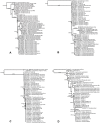Sloth hair as a novel source of fungi with potent anti-parasitic, anti-cancer and anti-bacterial bioactivity
- PMID: 24454729
- PMCID: PMC3893167
- DOI: 10.1371/journal.pone.0084549
Sloth hair as a novel source of fungi with potent anti-parasitic, anti-cancer and anti-bacterial bioactivity
Erratum in
- PLoS One. 2014;9(1). doi:10.1371/annotation/10c47668-8c49-48d2-ba65-60420af463b6
Abstract
The extraordinary biological diversity of tropical forests harbors a rich chemical diversity with enormous potential as a source of novel bioactive compounds. Of particular interest are new environments for microbial discovery. Sloths--arboreal mammals commonly found in the lowland forests of Panama--carry a wide variety of micro- and macro-organisms on their coarse outer hair. Here we report for the first time the isolation of diverse and bioactive strains of fungi from sloth hair, and their taxonomic placement. Eighty-four isolates of fungi were obtained in culture from the surface of hair that was collected from living three-toed sloths (Bradypus variegatus, Bradypodidae) in Soberanía National Park, Republic of Panama. Phylogenetic analyses revealed a diverse group of Ascomycota belonging to 28 distinct operational taxonomic units (OTUs), several of which are divergent from previously known taxa. Seventy-four isolates were cultivated in liquid broth and crude extracts were tested for bioactivity in vitro. We found a broad range of activities against strains of the parasites that cause malaria (Plasmodium falciparum) and Chagas disease (Trypanosoma cruzi), and against the human breast cancer cell line MCF-7. Fifty fungal extracts were tested for antibacterial activity in a new antibiotic profile screen called BioMAP; of these, 20 were active against at least one bacterial strain, and one had an unusual pattern of bioactivity against Gram-negative bacteria that suggests a potentially new mode of action. Together our results reveal the importance of exploring novel environments for bioactive fungi, and demonstrate for the first time the taxonomic composition and bioactivity of fungi from sloth hair.
Conflict of interest statement
Figures

Similar articles
-
Bioactivity of fungal endophytes as a function of endophyte taxonomy and the taxonomy and distribution of their host plants.PLoS One. 2013 Sep 16;8(9):e73192. doi: 10.1371/journal.pone.0073192. eCollection 2013. PLoS One. 2013. PMID: 24066037 Free PMC article.
-
Morphology of hair of two- and three- toed sloths (Edentata: Bradypodidae).Rev Biol Trop. 1986 Nov;34(2):243-6. Rev Biol Trop. 1986. PMID: 3423336
-
Screening and evaluation of antiparasitic and in vitro anticancer activities of Panamanian endophytic fungi.Int Microbiol. 2011 Jun;14(2):95-102. doi: 10.2436/20.1501.01.139. Int Microbiol. 2011. PMID: 22069153 Free PMC article.
-
On the move: sloths and their epibionts as model mobile ecosystems.Biol Rev Camb Philos Soc. 2021 Dec;96(6):2638-2660. doi: 10.1111/brv.12773. Epub 2021 Jul 26. Biol Rev Camb Philos Soc. 2021. PMID: 34309191 Free PMC article. Review.
-
IDLY INFECTED: A REVIEW OF INFECTIOUS AGENTS IN POPULATIONS OF TWO- AND THREE-TOED SLOTHS (CHOLOEPUS SPECIES AND BRADYPUS SPECIES).J Zoo Wildl Med. 2021 Jan;51(4):789-798. doi: 10.1638/2018-0188. J Zoo Wildl Med. 2021. PMID: 33480559 Review.
Cited by
-
Antiplasmodial activity of Cocos nucifera leaves in Plasmodium berghei-infected mice.J Parasit Dis. 2020 Jun;44(2):305-313. doi: 10.1007/s12639-020-01207-7. Epub 2020 Mar 9. J Parasit Dis. 2020. PMID: 32499668 Free PMC article.
-
Subcutaneous phaeohyphomycotic nodule due to Phialemoniopsis hongkongensis sp. nov.J Clin Microbiol. 2014 Sep;52(9):3280-9. doi: 10.1128/JCM.01592-14. Epub 2014 Jun 25. J Clin Microbiol. 2014. PMID: 24966363 Free PMC article.
-
Mass spectrometry tools and workflows for revealing microbial chemistry.Analyst. 2015 Aug 7;140(15):4949-66. doi: 10.1039/c5an00171d. Analyst. 2015. PMID: 25996313 Free PMC article. Review.
-
Opportunistic Sampling of Roadkill as an Entry Point to Accessing Natural Products Assembled by Bacteria Associated with Non-anthropoidal Mammalian Microbiomes.J Nat Prod. 2017 Mar 24;80(3):598-608. doi: 10.1021/acs.jnatprod.6b00772. Epub 2016 Nov 21. J Nat Prod. 2017. PMID: 28335605 Free PMC article.
-
Beyond the Lab: What We Can Learn about Cancer from Wild and Domestic Animals.Cancers (Basel). 2022 Dec 14;14(24):6177. doi: 10.3390/cancers14246177. Cancers (Basel). 2022. PMID: 36551658 Free PMC article. Review.
References
-
- Dye C, Mertens T, Hirnschall G, Mpanju-Shumbusho W, Newman RD, et al. (2013) WHO and the future of disease control programmes. Lancet 381: 413–418. - PubMed
-
- World Health Organization. Neglected tropical diseases [Online]. Available: http://www.who.int/neglected_diseases/en./ Accessed 2013 Apr 30.
-
- Falagas ME, Bliziotis IA (2007) Pandrug-resistant Gram-negative bacteria: the dawn of the post-antibiotic era? Int J Antimicrob Agents 29: 630–636. - PubMed
-
- Soerjomataram I, Lortet-Tieulent J, Parkin DM, Ferlay J, Mathers C, et al. (2012) Global burden of cancer in 2008: a systematic analysis of disability-adjusted life-years in 12 world regions. Lancet 380: 1840–1850. - PubMed
Publication types
MeSH terms
Substances
Grants and funding
LinkOut - more resources
Full Text Sources
Other Literature Sources
Medical
Molecular Biology Databases

